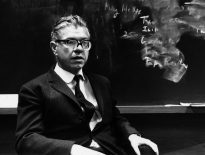I don’t think I did anything significant the afternoon I saw the movie “Awakenings”. The feeling that I had reached the heart of the human condition strongly impressed me with the idea that we are born captive in a limited nature, and that gave me a heavy feeling of loss.
Released in 1990, the film tells the story of neurologist Oliver Sacks, known for his research on the neurological impact of music and admired for his essay on life and death that he wrote in the New York Times after he was diagnosed with brain cancer.
Awakenings dramatizes an episode of Sacks’ career, who—from being a bookworm comfortable with books but clumsy with humans—ends up being assigned to the neurology department of a Bronx hospital. And, as if it was not enough that he’d been separated from the world of books and thrown into the unpredictable world of direct patient relationships, the doctor—fictionalized as the American Malcolm Sayer—was moved to a ward with catatonic patients.
Of all the immobilized patients, with their fixed expressions, Malcolm attaches himself most to Leonard Lowe, who manages to communicate with the doctor through an Ouija board (a wooden board containing the letters of the alphabet). The drama is mostly focused on Leonard, who is receiving a dose of a then-experimental substance, L-Dopa and who comes back to life after decades of being imprisoned by a disease that prevented him from moving, speaking, and living like an ordinary man.
Excited by the result, Malcolm puts all the patients in the ward under treatment with L-Dopa, obtaining spectacular results. Patients who had been given no chance by the hospital management (the “vegetables” that seemed devoid of any personality) as well as the patients enslaved by tics or atypical noisy reactions, normalize. The appearance of healing gives Malcolm wings, but these are suddenly cut off when side effects begin to appear.
The way the triple Oscar-nominated movie continues is supposed to be an ode to the joy of being alive, enjoying previously ignored privileges—from the freedom to move on your own, the ability to speak, the ability to feed yourself independently, to choosing what you want to eat, or feeling and confessing a romantic interest. And certainly, looking at all these simple miracles that we experience every day, we should be overwhelmed with gratitude for the fact that they belong to us. Nevertheless, “no miracle is easy,” as the movie’s tagline says.
When Leonard asks the hospital officials to allow him to continue the treatment by saying that he would do all those things that they take for granted in their lives, he is actually moralizing the spectator stuck in their dissatisfaction, paralyzed by self-sufficiency. However, at the same time as highlighting the beauty of normal life, the movie also emphasizes the shocking injustice done to those who cannot conform to the norm, no matter how much they want to.
The movie gets the viewer to fall in love with Leonard more than it gets them to fall in love with their own life. However, it goes further by reaching that fragility inherent in any human and to make their emotions vibrate more at the thought of the ephemerality of all their privileges than at the thought of their present reality. And that gives a really painful nuance to the joy of knowing that they, the viewers, are healthy.
It is easier to insinuate the elusive fear that, one day, this good will be crushed under the pressure of health problems, of loneliness, of the awareness of the fact that our powers have been irreversibly diminished, than it is to convey a satisfaction with the present. Perhaps there are some who watch the movie in a present that already poses great challenges, who are even more shattered by the thought that they have no guarantees that the future will be better.
From this perspective, in my mind, Awakenings seems to be strangely related to a film of a different kind, a different country (Sweden), and a completely different subject: A Man Called Ove. I’ll explain why.
A Man Called Ove is a fictional biography. Nevertheless, there is something about biographies, perhaps seeing the life of the character as a whole, which ushers the viewer into a learning atmosphere. The subject is life, and the teachers are the ones who have already gone through it, from beginning to end.
Ove is a senior who has outgrown his life; even the suit he wears is a symbol of this idea. We meet him in the midst of a crisis: the railway company for which he has worked for decades, after taking over his father’s job, suggests that he should retire. Offended by the prospect, Ove resigns and focuses on “guarding” the small residential neighborhood in which he lives. However, just as his life has changed, so have the people in the neighborhood, and with the new younger tenants, new, much looser rules are being imposed. Ove feels that there is no point in living and unsuccessfully tries to commit suicide.
Before each attempt, moving scenes go by before his eyes, scenes that he has experienced throughout his life and that shed a completely different light on his daily complaints. Ove has experienced a substantial amount of suffering. His mother died when he was a child, and his father died in an accident on the day he graduated from high school.
We also find out that the grave he visits—so often that no dust gets the opportunity to settle—belongs to his wife, who died of cancer six months prior. Years before, they had both been involved in a bus accident in which his wife lost a pregnancy and became paralyzed, while Ove had been left with only a few scratches.
Every time something bad happened to his loved ones, nothing happened to him. Although each time he was one step away from the place of the tragedy, by virtue of an insignificant decision, he was both protected and did not even see the tragedy actually happening. (A few seconds before his wife’s accident, for example, he had gone to the toilet of the bus to wash his face.) However, although he is not a direct victim of evil, Ove feels and bears the suffering of his loved ones as if it were his own. Therefore, he feels deeply betrayed by life that did not take care of those whom he deemed the most precious people in the world.
At this point, the messages of the two movies meet. After watching Awakenings, the viewer suffers from a type of Survivor’s Guilt, the same disorder that has plagued Ove’s life since the beginning of the movie. But Ove is slowly discovering a solution for his life.
At the insistence of the family of an Iranian immigrant who has just moved to the neighborhood, the pensioner discovers that he can still be useful to those around him. He helps them integrate, and they, in turn, reassure him that love still exists, and that there are still ways in which he can offer and receive it. The premises of his depression have not changed (his loved ones will not return), but, provoked by his new neighbors, he manages to see life-saving details in the pain he has experienced.
One such detail is the fact that, although paralyzed, his wife never gave up, pursuing a challenging but successful teaching career. Another detail is that, although she lost their child, the love she had prepared for him she passed on to the most unpromising children in the class, transforming their destiny.
When you are not the one suffering, there are two equally dangerous extremes in which you can fall: you can either underestimate the suffering of the other, diminishing it so that you can live next to it, or overestimate it, imagining how you would react to such a suffering, or miscalculating it as a result of circumstances.
I like to think that with his return to better feelings for life, Ove learned that humans experience suffering and the solution to it simultaneously—even if the pain can make them see only the first of the two. Suffering people judge their life according to coordinates that are intrinsic to their world. Thus, one who looks from the outside, in spite of their good intentions, will not be able to understand the constellation of the other person’s pain. They will not be able to live it the same way. They will either diminish it, or exaggerate it.
Interestingly, Oliver Sacks also pointed to such an interpretation in an evaluation of his experiment which he did for the press. In a televised interview, he said that he saw a testament to possible dignity in the incident even in a context where hope, according to its “normal” definitions, was no longer present.
Sacks referred to the fact that some of the patients, awakened after decades in a world to which they were not adapted and noticing the debilitating side effects of L-Dopa, chose to stop taking the drug and return to the life they had before the experiment: limited in terms of capacity, but familiar.
In this sense, the movie can be inspiring even for those prone to imagine a bleak future. Maybe life will place them in extreme situations, for which they are not ready at the moment. But there is no point in worrying about a possible, hypothetical situation that might not even happen.
“Each day has enough trouble of its own” because the present is the only certainty. As for the rest (past or future), we can either be suspicious or faithful. The past and the future are not within our reach, but are in God’s hands. Since they are not in our hands, it is in our best interest to believe that, as the Bible teaches, the God who loves faithfully and constantly will take care of us in ways that we cannot even fathom.



















